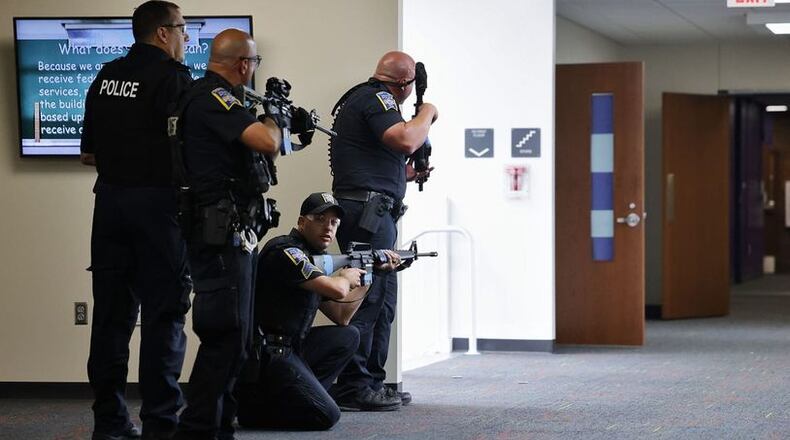Last Friday saw eight schools in the Greater Dayton, Springfield and Cincinnati areas — and more elsewhere in Ohio — targeted for fake calls of armed attackers shooting up schools prompting local police and SWAT teams to race to school campuses. Other schools nationwide were also hit with the bogus phone calls.
The illegal practice, dubbed “swatting,” is a growing concern and now has prompted some state legislators to act with a proposed bill greatly increasing punishment for offenders, according to reporting from the Columbus Dispatch.
State Rep. Kevin Miller, R-Newark, and state Sen. Andrew Brenner, R-Delaware, introduced companion bills to increase the penalties on swatting.
The legislation would make it a third-degree felony and elevate it to a first-degree felony if anyone were seriously injured due to the false report. Those convicted could also be ordered to pay the government for resources spent on the hoax call, under the bill.
“I’m appalled by this type of behavior. It especially sickens me that they’d do this to schools. Think of the emotional impact that these types of incidences have on all those involved,” said Miller, a retired state trooper.
“Now these young people think someone is there who wants to harm them. It sickens me,” said Miller.
The impact from bogus threats are all too real, said Gina Gentry-Fletcher, spokeswoman for the 10,000-student Fairfield Schools in Butler County.
“Despite doing safety drills to prepare our students and staff, when non-credible threats occur, they can cause unfair emotional stress to our students, parents, and staff. And we lose time — valuable instructional time — relationship building with our students and normal operations, among other things,” Gentry-Fletcher said.
“It is disgusting to know that there are ‘pranksters’ from anywhere who take perverse pleasure in sowing fear when they swat schools,” said Tracey Carson, spokeswoman for Mason Schools, Warren County’s largest school system.
Officials in Ohio’s ninth largest school system, Lakota Schools in Butler County, have in recent years dealt with their own share of false threats of violence.
Betsy Fuller, spokeswoman for the 17,200-student district, said the hoaxes incur a cost for schools but also for school parents, who may have to disrupt their work schedules to pick up and tend to their children who are sent home as result of a precautionary school closure.
“While it is difficult to calculate how many hours a false threat may take away from the daily responsibilities of our administrators, SROs (school police officers, also called school resource officers) or staff, it is important to also consider the financial impact a hoax may have on our families,” said Fuller.
“Parents may have to find childcare if a school is forced to close, pick up students during the day or request time off from work. This is in addition to the emotional impact a false threat can have on both staff and students.”
The school shooting massacres of recent years, most recently the deadly armed attack in May at an elementary in Uvalde, Texas that saw 19 children and two teachers gunned down, has further ramped up already heightened school security concerns and measures by local schools.
State and federal grants made available since May’s massacre have been pursued and awarded to many area schools throughout Greater Cincinnati, Dayton and Springfield.
But the spending isn’t all focused on hardening school building targets.
Student mental health issues, particularly among those troubled youth who have expressed a potential for threatening violence or carrying out such actions like swatting, are now a higher priority, said school officials.
“It’s important to recognize that caring for our students’ social and emotional wellness is an important preventative factor,” said Holli Morrish, spokeswoman for Talawanda Schools.
“We invest in many resources to create a safe environment and it goes beyond school resource officers (SROs) in each school. In addition to a district wellness person, who vets all of our programs with trusted community physicians and other wellness experts in the local (community), we have partnerships with health providers and we have counselors and school psychologists in each school along with a school social worker in each school,” Morrish said.
But sometimes what works best is meeting the threat of violence — whether credible or a hoax — with the threat of punishment, said school officials.
In recent years all schools have altered their school policies and student punishments to address the growing trend of fake school threats. And in response to the swatting trend, many schools are amplifying their warnings to students with those warnings being echoed by area law enforcement officials.
“Non-credible school hoaxes are a serious offense that our school district also takes very seriously,” warned Mason school officials in a message sent after last Friday’s swatting incidents at other districts drew national attention.
Carson said “last year, we had a Mason student who spent time at the Warren County Juvenile Detention Center and served significant school consequences after a ‘joke’ threat.”
“The student is a good kid, who made a terrible mistake that unfortunately ended up being a lesson learned the hard way,” she said.
And Hamilton County Prosecutor Joe Deters wrote in a recent statement those involved in hoaxes should be “ready for prison.”
“The threat of a school shooting is every parent’s worst nightmare,” Deters said. “Orchestrating a hoax like this is beyond offensive. It is stupid and completely illegal. Innocent people and first responders could have easily been injured.”
“Law enforcement will find out who did this. And when apprehended, they better be ready for prison.”
Journal-News media partner WCPO contributed to this story.
About the Author

